Building Emotional Resilience Through Collective Strength
In an increasingly complex world, emotional resilience has become a pivotal skill for navigating life's challenges. Group processing emerges as a vital approach in cultivating this resilience, offering a safe space for sharing, learning, and mutual support. This article explores how structured group activities and therapeutic techniques enhance emotional strength, fostering recovery, growth, and well-being.
Understanding Emotional Resilience and Its Significance
What is emotional resilience?
Emotional resilience refers to the ability to adapt, recover, and excel amid stress, setbacks, or unexpected challenges. It encompasses mental, emotional, and behavioral flexibility, allowing individuals to maintain their well-being despite adversity. Resilience is not a fixed trait but a skill that anyone can develop over time.
Numerous factors influence resilience, including age, past experiences, social support networks, and mindset. Cultivating resilience involves practices like mindfulness, nurturing positive relationships, self-awareness, and proactive coping mechanisms. With resilience, people learn to see difficult situations as temporary and maintain motivation for personal growth despite obstacles.
This capacity to bounce back and grow stronger is crucial for navigating life's ups and downs with balance and purpose. Ultimately, resilience enables individuals to handle challenges effectively, fostering resilience becomes a continuous process of behaviors, thoughts, and actions that support recovery and thriving.
Why is emotional resilience important?
The significance of emotional resilience lies in its role in mental health and overall life satisfaction. It helps individuals respond more effectively to stressful or challenging situations, aiding in faster recovery and maintaining emotional stability.
Having resilience acts like a protective shield against stress-related health issues such as anxiety and depression. It also enhances one’s capacity to build and maintain meaningful relationships, adapt to change, and seize opportunities for growth.
Resilience supports learning and adaptability, allowing individuals to turn adversity into an avenue for developing new insights and strength. By fostering resilience, individuals can lead more fulfilling lives, face uncertainties with confidence, and support their mental and physical health. Overall, resilience is a foundational element for thriving amid life's inevitable difficulties.
The Role of Group Processing in Building Resilience
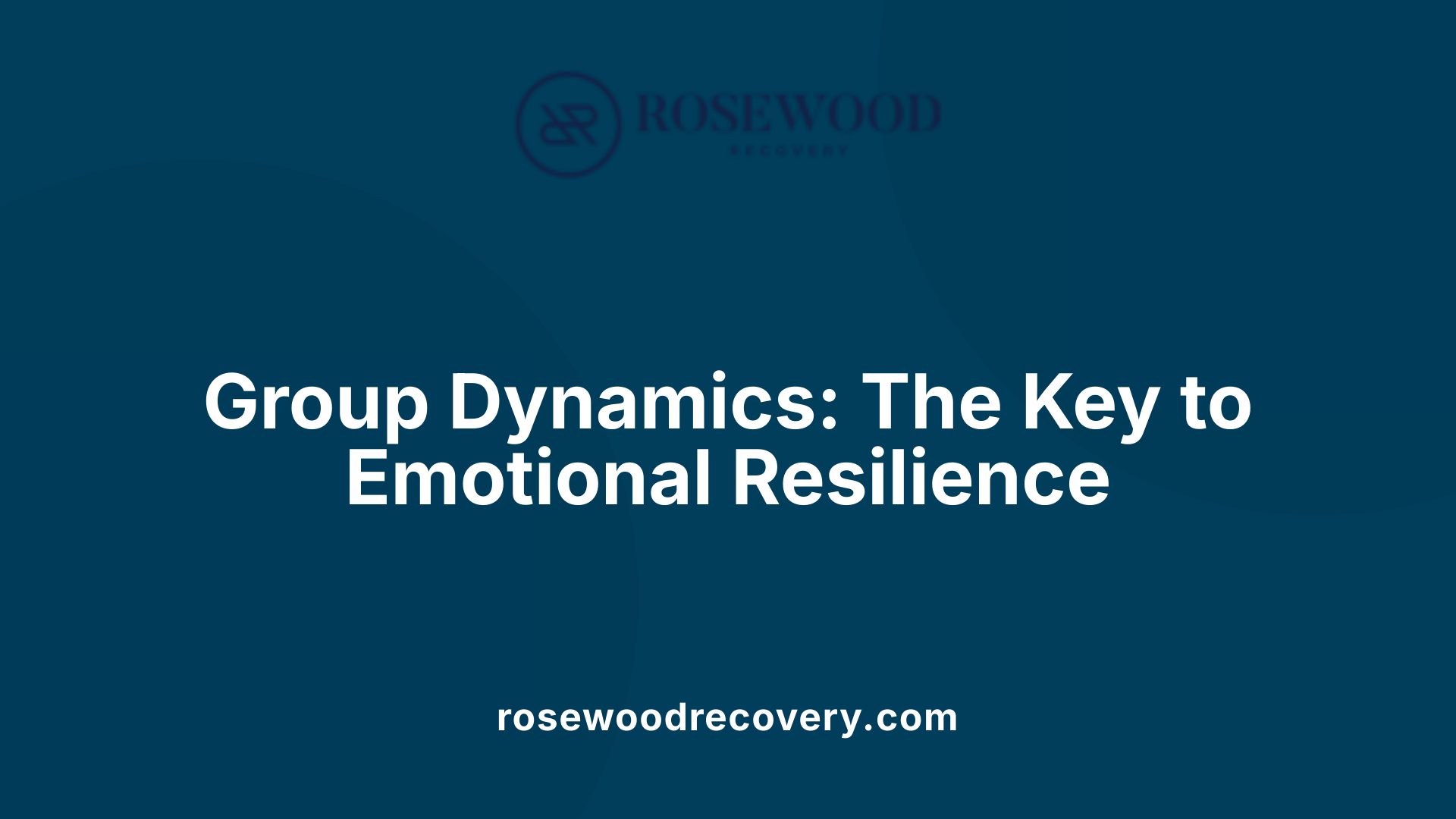
How does group processing help build emotional resilience?
Group therapy settings provide a vital platform for fostering emotional resilience by establishing a supportive environment where individuals feel safe to express their experiences, feelings, and challenges. Sharing personal stories within the group helps participants realize they are not alone in their struggles, which builds a sense of belonging and mutual understanding.
Activities such as storytelling, role-playing, and reflective discussions facilitate emotional expression and help individuals develop effective coping strategies. These exercises also improve communication skills and enhance emotional regulation, empowering members to handle stress more adaptively.
The shared experiences in group therapy foster empathy among participants, nurturing a community of support that promotes healing and growth. Facilitators guide these interactions, ensuring emotional safety and helping members set healthy boundaries.
Furthermore, group therapy encourages mindfulness practices and reframing of negative thoughts, strengthening mental resilience.
Overall, engaging in group processing cultivates vital interpersonal skills, confidence, and resilience. It creates a sense of purpose and connection, enabling individuals to better adapt to adversity, recover from setbacks, and maintain emotional stability.
How empathy and mutual understanding are cultivated
Empathy develops naturally in group settings as participants listen to each other's stories and perspectives. This understanding deepens emotional bonds and promotes compassionate responses, which are crucial during stressful times.
Mutual understanding enhances resilience by reducing feelings of isolation and fostering hope. Knowing others face similar challenges allows individuals to view their difficulties as part of a shared human experience, increasing their capacity to cope.
The importance of shared experiences
Shared experiences act as a foundation for solidarity and support within the group. They enable members to see that their feelings and reactions are valid, which helps normalize their struggles and promotes acceptance.
Discussing common challenges like illness, loss, or relationship issues helps participants learn from each other’s coping mechanisms and insights. These interactions often lead to the development of new perspectives and resilience-building strategies.
In summary, group therapy, through shared experiences and cultivated empathy, offers a powerful avenue for enhancing emotional resilience. It encourages healing, strengthens interpersonal relationships, and equips individuals with the skills necessary to navigate life's adversities.
Benefits of Group Therapy and Processing for Emotional Resilience
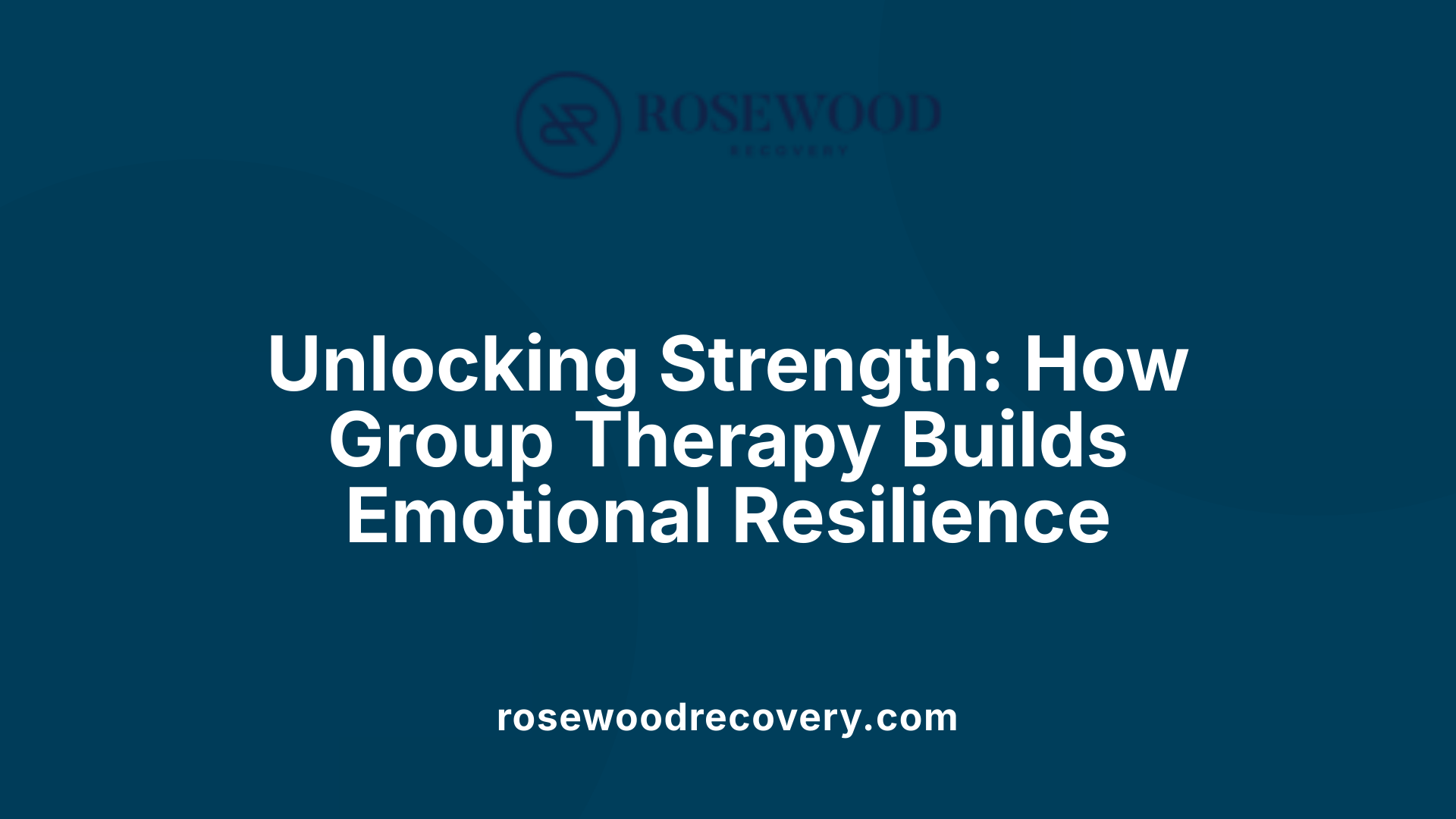
What are the benefits of group therapy and processing for emotional resilience?
Group therapy plays a significant role in strengthening emotional resilience by creating a safe space where individuals can openly share their experiences and challenges. A major advantage is the reduction of loneliness and stigma, as participants find comfort in knowing they are not alone in their struggles. Connecting with others who understand their situation fosters a sense of community and belonging, which is vital for emotional healing.
Through group interactions, participants develop essential coping skills, such as emotion regulation and effective communication. Sharing stories and listening to others provide new perspectives, offer validation, and encourage interpersonal learning. These processes build trust, improve social support networks, and help individuals manage stress more effectively.
Moreover, group therapy enhances emotional literacy by teaching members to recognize and express emotions clearly. This, combined with practicing empathy and active listening, boosts emotional intelligence and resilience. Incorporating positive psychology elements like gratitude, hope, and forgiveness during sessions further improves mental well-being.
In addition to individual growth, group therapy fosters systemic awareness, increasing understanding of broader social and familial dynamics. Engaging in structured activities such as role-playing, storytelling, and mindfulness exercises helps participants explore and reframe their emotional responses.
Overall, regular participation in group settings encourages communal healing which, in turn, empowers individuals to face future adversities with confidence. It supports healing from trauma, reduces feelings of shame, promotes positive behavioral changes, and strengthens emotional resilience.
| Benefit | Description | Additional Notes |
|---|---|---|
| Reduces loneliness and stigma | Sharing experiences decreases feelings of isolation | Key for emotional validation |
| Enhances social support | Builds community networks | Critical for resilience |
| Develops coping skills | Learning new ways to manage stress | Includes emotional regulation and communication |
| Fosters emotional intelligence | Improving understanding and expression of emotions | Leads to better interpersonal relationships |
| Promotes systemic awareness | Broader understanding of social influences | Facilitates capacity for empathy |
Research indicates that these processes are effective across various populations, including trauma survivors, individuals with mental health conditions, and those experiencing social isolation. To maximize benefits, engagement in group therapy should be supported with structured activities, empathetic facilitation, and ongoing peer support.
Mechanisms Through Which Group Activities Foster Emotional Strength
What mechanisms do group activities use to foster emotional strength?
Group activities are structured to create a nurturing environment that promotes emotional development and resilience. A fundamental mechanism is the establishment of a supportive space where participants feel safe to share their experiences, thoughts, and feelings. This openness encourages mutual respect and understanding, which are essential for emotional healing.
Shared activities, such as mindfulness exercises, art therapy, journaling, or role-playing, serve as practical tools that facilitate emotional regulation and self-awareness. These activities help individuals identify and understand their emotions more clearly, enabling healthier responses to stressful or challenging situations.
An important element in this process is social learning. In group settings, individuals gain sources of self-efficacy through three main channels:
| Mechanism | Description | Effect on Emotional Resilience |
|---|---|---|
| Personal Mastery | Success in group activities boosts confidence | Increases belief in ability to handle emotional challenges |
| Vicarious Experience | Observing peers successfully managing emotions | Enhances motivation and provides role models |
| Verbal Persuasion | Encouragement from group leaders and peers | Reinforces self-belief and perseverance |
Additionally, group interactions foster a sense of universality—that members realize they are not alone in their struggles. This shared experience diminishes feelings of isolation and creates emotional solidarity.
Interpersonal skills are also developed through group participation. Practice in active listening, empathy, and effective communication strengthens personal relationships outside the group, further contributing to emotional resilience.
The cohesion or positive emotional connection among group members acts as a vital mechanism. This sense of belonging and mutual support empowers individuals, leading to clinical improvements and greater emotional strength.
In summary, group activities promote emotional resilience using mechanisms such as supportive sharing, skill-building, social modeling, and fostering positive bonds. Collectively, these foster an environment where individuals can recover from adversity, develop healthier coping strategies, and build enduring emotional strength.
Therapeutic Techniques That Enhance Resilience in Group Settings
What therapeutic techniques in group processing enhance resilience?
Group therapy offers a supportive environment where individuals can develop greater resilience through specific therapeutic techniques. Central among these are active listening and validation, which create a safe space for sharing experiences. By feeling understood and accepted, group members are more likely to open up, explore their emotions, and build trust.
In addition, emotional sharing and guided reflection play a significant role. These practices help individuals process past experiences, identify modifiable thoughts, and develop cognitive and emotional flexibility. Such activities reinforce positive coping mechanisms, which are essential for resilience.
Evidence indicates that techniques such as cognitive restructuring, mindfulness exercises, and social support within group contexts effectively build resilience. Cognitive restructuring, often used in cognitive-behavioral therapy (CBT), helps individuals challenge negative thought patterns and develop a more optimistic outlook.
Mindfulness practices foster present-moment awareness, reducing stress and enhancing emotional regulation. Mindfulness-based stress reduction (MBSR) programs, when incorporated into group settings, can improve self-awareness and decrease symptoms of anxiety and depression.
Social support is fundamental. Sharing experiences within the group helps reinforce a sense of community, reduce feelings of isolation, and promote hope. These interactions can bolster self-efficacy and optimism, which are critical for bouncing back from adversity.
Therapeutic techniques from approaches like Acceptance and Commitment Therapy (ACT) and mindfulness-based interventions can also be integrated into group therapy. These methods focus on accepting difficult emotions while committing to meaningful actions, fostering resilience.
Overall, structured group interventions that combine active listening, validation, cognitive restructuring, mindfulness, and social support can significantly enhance resilience. They do so by improving emotional regulation, fostering adaptive thinking, and strengthening social networks.
Implementing these techniques within group therapy leads to better mental health outcomes, empowering individuals to navigate stress and trauma more effectively and transition towards resilience with confidence.
Community and Support Networks in Building Resilience
How can community and support networks contribute to building emotional resilience?
Community and support networks play a vital role in fostering emotional resilience by creating a foundation of social connections. These connections offer emotional comfort, practical resources, and validation, which are essential for coping with stress and adversity. When individuals feel supported, their neurobiological stress responses, such as cortisol levels, can decrease, making it easier to manage crises.
Support networks also encourage positive coping strategies, including help-seeking, problem-solving, and adaptive thinking. This not only enhances personal resilience but also provides protective benefits against mental health issues like depression and post-traumatic stress disorder (PTSD). When people participate in community healing activities or peer support groups, they experience a sense of belonging and shared purpose, which further strengthens their emotional fortitude.
Community programs—such as restorative justice, mental health initiatives, and advocacy groups—empower individuals by promoting recovery from trauma and fostering social cohesion. These collective efforts reinforce resilience at both individual and community levels. The collective strength built through such networks sustains individuals through challenging times, encouraging them to bounce back and thrive.
Nurturing a supportive environment promotes emotional stability and enhances the ability to recover from setbacks. By establishing trust, fostering open communication, and encouraging mutual aid, communities strengthen their overall resilience.
Role of social connections
Social connections are the backbone of resilience. They provide emotional support, reduce feelings of loneliness, and give individuals opportunities to express and process their feelings.
Community healing and shared purpose
Community initiatives focused on healing and shared goals help create a sense of belonging. Working together toward common objectives fosters unity, hope, and purpose, vital components for emotional recovery.
Support from peer groups and networks
Peer groups offer safe spaces where individuals can share experiences, learn from others, and develop coping skills. These networks boost confidence, reinforce resilience, and promote mental health.
| Aspect | Description | Impact on Resilience |
|---|---|---|
| Social Connections | Building meaningful relationships | Reduces stress, promotes coping, and provides emotional comfort |
| Community Healing | Collective efforts to recover and strengthen bonds | Fosters shared purpose, hope, and social cohesion |
| Peer Support Networks | Support groups and peer-led initiatives | Enhances emotional expression, provides validation, and encourages healing |
Overall, community and support networks do not just provide immediate relief—they nurture long-term resilience by creating environments where individuals feel valued, understood, and empowered to face adversity.
Trauma and Grief Recovery within Group Settings
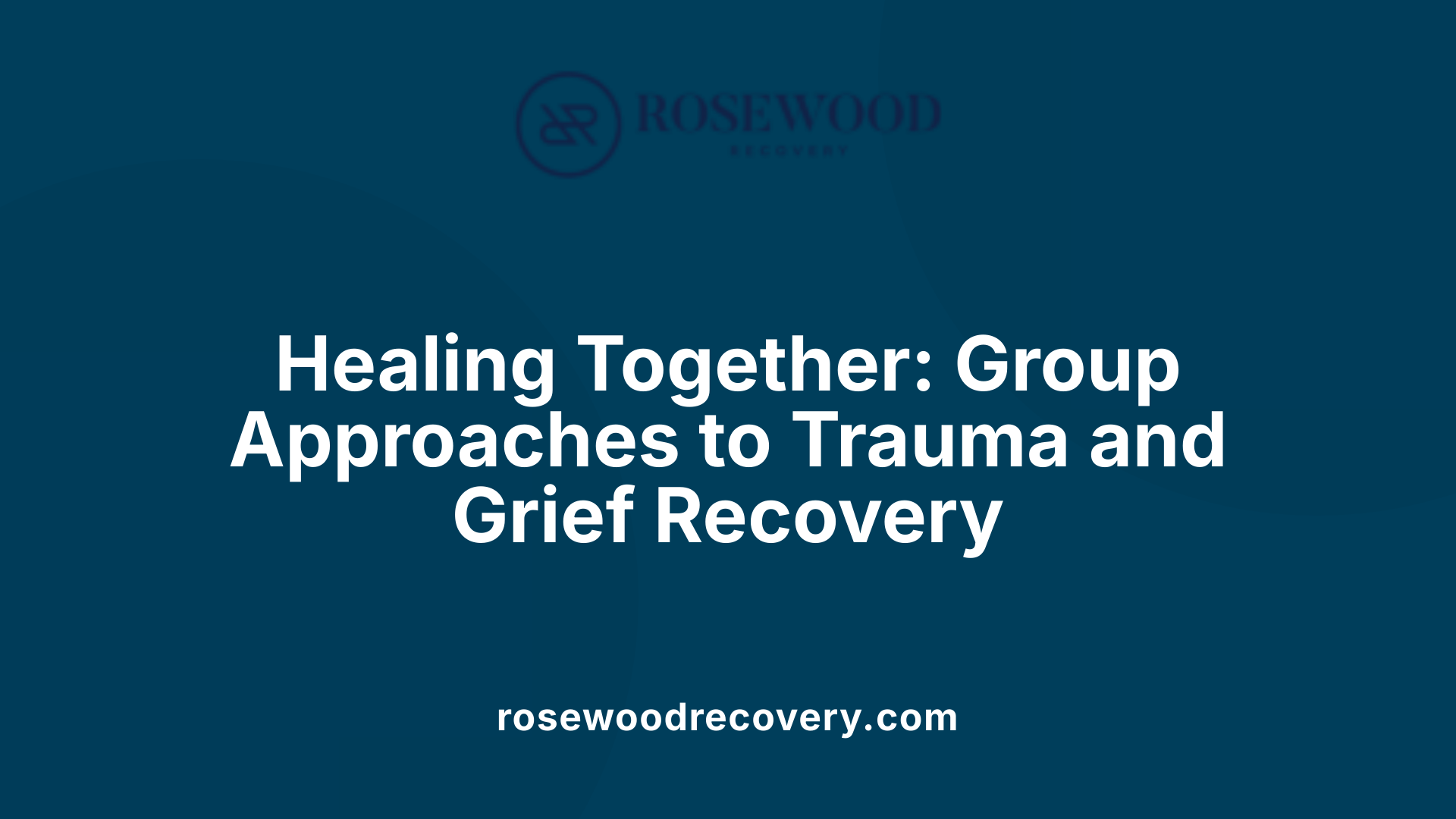
Can trauma and grief recovery be facilitated through group processing?
Trauma and grief recovery are often complex and emotionally demanding processes. Utilizing group therapy creates a supportive environment where individuals can safely share their experiences and feelings related to trauma and loss.
Group settings foster a sense of shared understanding, helping participants realize they are not alone in their struggles. This normalization of emotions such as anxiety, anger, sadness, or denial reduces feelings of isolation often associated with trauma and grief.
Various therapeutic techniques are employed within these groups to address distressing memories and emotional pain. Trauma-focused cognitive-behavioral therapy (TF-CBT) is one effective approach that helps reframe negative thoughts and develop coping strategies. Eye Movement Desensitization and Reprocessing (EMDR) is another modality used to process traumatic memories and alleviate associated symptoms.
Healing through shared experiences involves mutual validation, emotional support, and reflection. Group members often find comfort in understanding that others face similar challenges, which reinforces resilience and fosters hope.
Processing grief and loss in a group also offers opportunities for expressing suppressed emotions and developing adaptive coping skills. Participants learn to manage intense feelings, reframe traumatic narratives, and find meaning beyond their pain. This collective process can promote post-traumatic growth, helping individuals rebuild their sense of safety, purpose, and emotional stability.
In summary, group therapy serves as a vital platform for trauma and grief recovery by providing emotional support, facilitating healing through shared experiences, and employing evidence-based therapeutic techniques to promote resilience and recovery.
Assessment and Practice: Strengthening Resilience and Emotional Intelligence
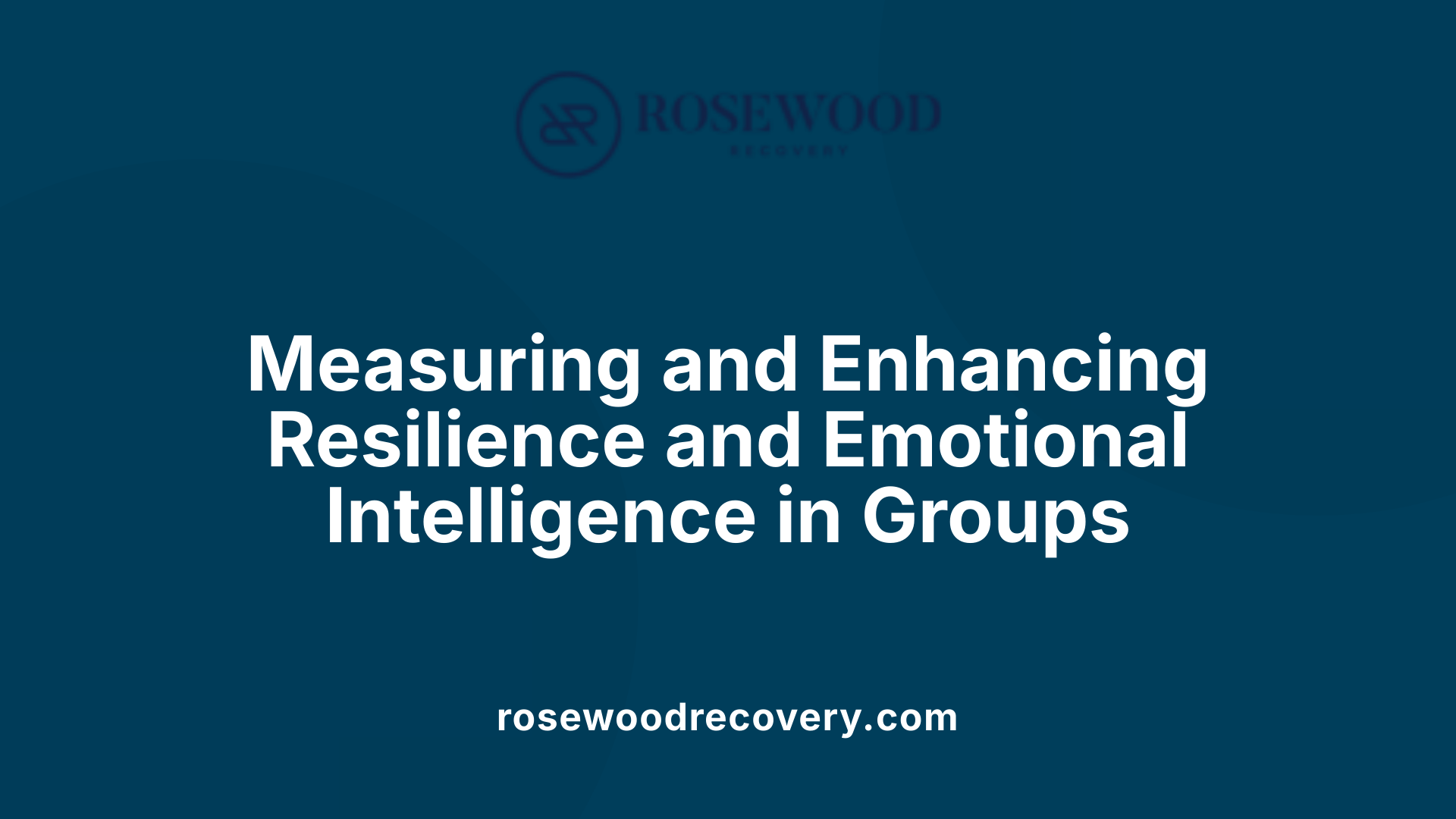
How can resilience and emotional intelligence be assessed and improved within group contexts?
Evaluating resilience and emotional intelligence (EI) in group settings involves using validated measurement tools. For resilience, the Connor-Davidson Resilience Scale (CD-RISC) is commonly employed, providing insights into an individual's capacity to adapt to adversity. Similarly, the Mayer-Salovey-Caruso Emotional Intelligence Test (MSCEIT) assesses various aspects of EI, including perceiving, understanding, and managing emotions.
These assessments give group facilitators a clear picture of each participant's strengths and areas needing development. Based on these results, targeted interventions are implemented to foster growth.
To enhance resilience and EI, facilitators often incorporate activities like mindfulness training, expressive writing, and self-awareness exercises. Mindfulness practices help individuals stay present and recognize their emotional states accurately, which is vital for emotional regulation. Expressive writing encourages participants to process feelings related to stress or trauma, fostering emotional clarity.
Group activities such as role-playing, open discussions, and emotional validation exercises promote the development of crucial skills like emotional perception, regulation, and social interaction. Repeated practice within a supportive environment promotes lasting change, helping individuals respond better to stressors, improve relationships, and build sustainable resilience.
Creating opportunities for reflection and feedback in groups encourages continuous growth. Over time, these strategies lead to improved mental health, greater social cohesion, and a more resilient outlook. This comprehensive approach ensures both accurate assessment and effective development of resilience and emotional intelligence in group contexts, fostering individuals' ability to navigate life's challenges with strength and adaptability.
Frameworks and Models for Developing Emotional Resilience
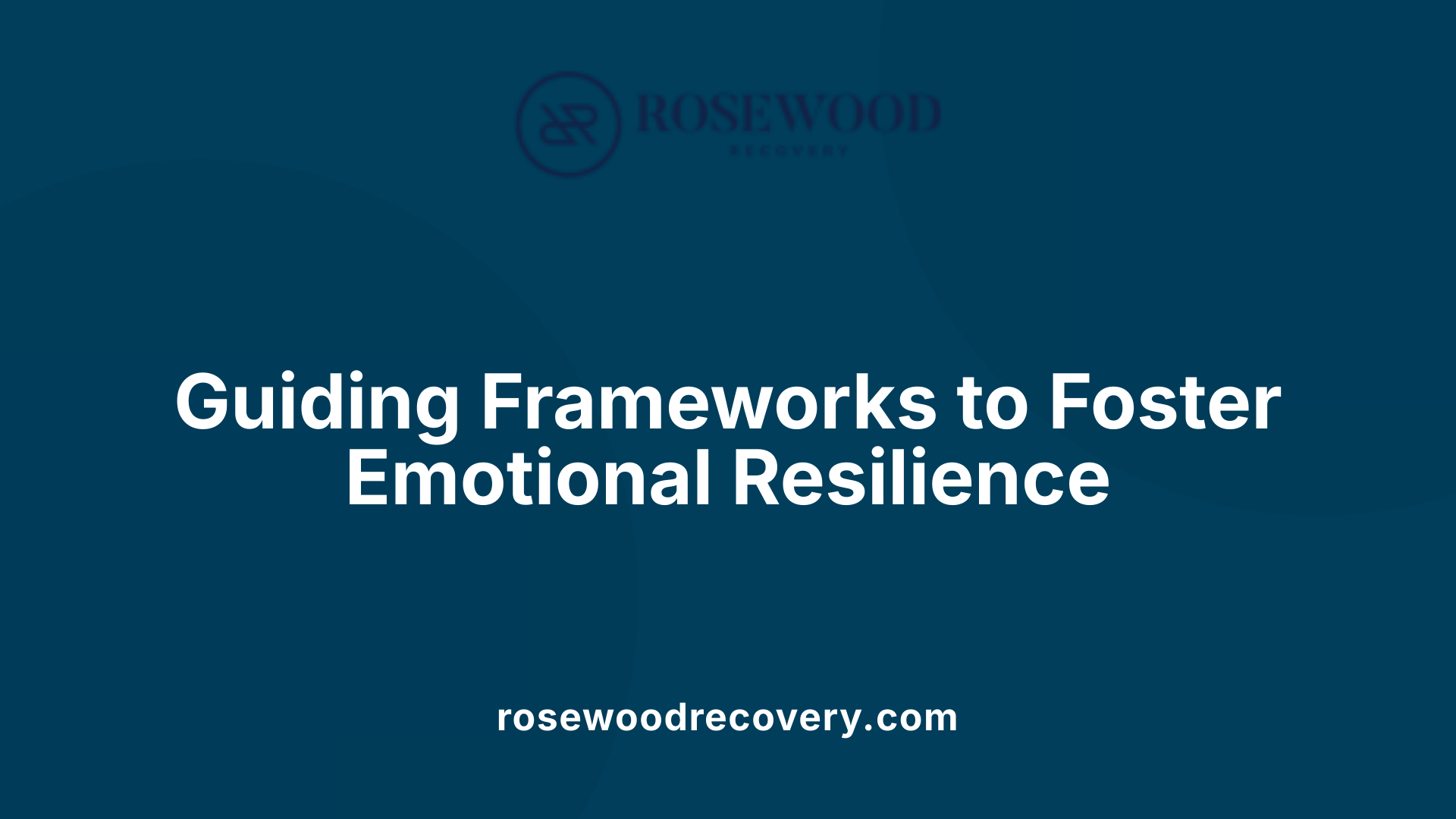 Understanding and cultivating emotional resilience can be guided by various frameworks and models that pinpoint the core elements involved in resilient behaviors and thoughts.
Understanding and cultivating emotional resilience can be guided by various frameworks and models that pinpoint the core elements involved in resilient behaviors and thoughts.
One influential model is Kenneth Ginsburg’s 7 C’s of Resilience. This framework identifies seven components crucial for resilience: competence, confidence, connection, character, contribution, coping, and control. These elements reflect personal qualities and social assets that foster the ability to adapt in challenging situations. Building on these components can help individuals develop emotional strength and navigate adversity more effectively.
Another important approach is Seligman’s 3 P’s model, which examines patterns of thinking that affect our response to stress. The 3 P’s include personalization (attributing events to oneself), pervasiveness (believing problems are widespread across life areas), and permanence (viewing setbacks as unchangeable). By recognizing and challenging these negative thought patterns, individuals can cultivate a more optimistic outlook, thus strengthening resilience.
Theoretical resilience frameworks offer a broader view of resilience as a dynamic process. For example, some models describe resilience as involving adaptive coping strategies that lead to a state of mental balance called equanimity. These models often use assessment tools like the Current Experience Scale (CES) to measure resilience levels and identify areas for development.
In healthcare, the Resilience Framework for Nursing and Healthcare conceptualizes resilience not only as an individual trait but also as a process that involves recognizing stressors, engaging in coping activities, and ultimately attaining a sense of equanimity. This approach emphasizes resilience as a process occurring in stages, which healthcare professionals can support and foster through targeted interventions.
By exploring and applying these models, individuals and practitioners can develop tailored strategies for enhancing emotional resilience, which in turn improves overall mental health and ability to recover from hardships.
Harnessing Collective Power for Resilient Futures
Building emotional resilience through group processing and therapy harnesses the collective strength of community, shared experiences, and therapeutic techniques. As individuals learn to navigate adversity with empathy, confidence, and adaptive skills, they foster not only personal growth but also contribute to a resilient society. Emphasizing the importance of supportive networks, professional guidance, and proactive coping strategies ensures that resilience remains a dynamic, developable skill capable of transforming lives and communities alike.
References
- Effect of Resilience-based Group Therapy Intervention on Coping in ...
- Developing resilience and harnessing emotional intelligence - PMC
- Building your resilience - American Psychological Association
- Strengthening Your Emotional Resilience With Emotionally Focused ...
- How Group Therapy Can Transform LGBTQ+ Relationships
- Understanding Emotional Resilience and How to Build It
- Resilience in the Workplace: How to Be Resilient at Work
- 10 Group Therapy Topics to Improve Mental Health and Well-being




